(continued)
The Surreal Story of Drinking Buddies, Good Reads, and Very Posh Hotels which are Not My Cup of Tea.
I was also surprised by some of the other language in these supposed 1901 and 1917 journal entries. They read to me like a modern author is pretending he was writing in 1901, but was not doing a very convincing job of it. Here are some particular words and phrases which are incongruous with the supposed date of the article.
Drinking Buddies. Let’s start with alleged words of Old Tom Morris, in the May 11, 1901 entry, where the author has Old Tom Morris explaining Andra Kirkaldy's planned meeting at the Royal Hotel:
“I also offered Andra to join us but he had a previous engagement at the Royal Hotel. Tom explained ‘drinking buddies.’”Below is an image generated by the Google Ngram Viewer, searching for the phrase “drinking buddies” and the related “drinking buddy.” Google Ngram is an incredible searchable database consisting of Google’s entire corpus of over 8 million books, and over a half trillion published words in American English and British English, combined. In short, it is a database for tracking and comparing the usage of published words and phrases over time, and it provides a useful tool for helping bring about an understanding when selected words and phrases were commonly used (if they were used at all.)
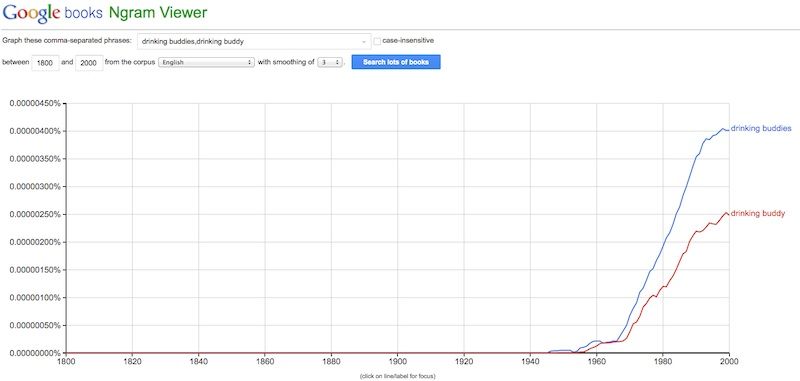
As you can see, the phrase “drinking buddies” and the related “drinking buddy” don’t seem to have been in use at all around 1901.
For comparison’s sake only, and to demonstrate how Google Ngram Viewer works, here is another phrase from the supposed journal entries, but one that actually was in use in 1901, “
a previous engagement.”
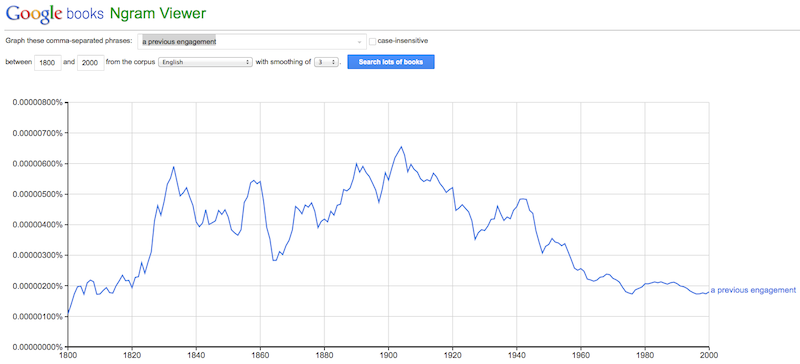
Note that this phrase was relatively more common in 1901 than it is now. If these journal entries really were written in 1901, we should expect to see plenty of words phrases like this, but no words and phrases which were not in use at the time.
Finding distinctly modern words and phrases being used in 1901 would be a bit like finding Old Tom on the first tee at The Old Course with a Big Bertha titanium driver.
Did Old Tom Morris coin the phrase “drinking buddies,” many decades before it showed up in common usage? It seems extremely unlikely.
Very Posh. It seems Mr. David Scott-Taylor must have been fond of phrase “very posh” to connote luxurious, elegant, high class accommodations. The supposed entry for July 20, 1901 uses the phrase “very posh” to describe the first class accommodations on a passenger liner, and then again to describe an elegant and luxurious hotel lobby.
But while the word “posh” has been around a very long time and has had different meanings (to connote a type of money, for instance, or possibly as slang for “a dandy”), the term as used in the supposed journal entries didn’t come into use until more until over a dozen years after it was supposedly used in the journal:
“Posh, meaning ‘smart, stylish, splendid, luxurious’ is first recorded in 1914, with the chiefly British strand of meaning, ‘typical of the upper classes; snooty’, following soon after.” http://blog.oxforddictionaries.com/2012/02/what-is-the-origin-of-posh/ “Origin: 1915–20.” http://dictionary.reference.com/browse/posh?s=tAnd the transcription doesn't just say “posh.” It twice says “very posh.” The phrase “very posh” is much a part of the language today, but this phrase was not is use in 1901.
Here is the Google Ngram Image. (The small red line at 1900 seems to be the result of a indexing error. The only book showing up from that period was mis-indexed and was actually published a century later.)
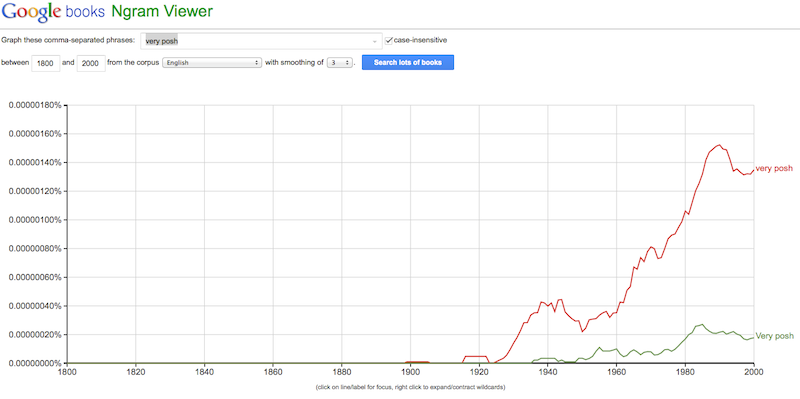 Surreal Backdrop
Surreal Backdrop. From Phil's transcription of the supposed journal entry dated April 16, 1917:
“The sound of distant guns and the eerie silence in between made for a serial backdrop to a conversation of home, hopes and laughter with a dear friend.”A “serial” backdrop? Surely this must either be a misspelling or a mis-transcription of “surreal backdrop,” otherwise it makes no sense in any era. According to numerous sources, including Oxford Dictionaries and Merriam Webster Dictionary, the word “surreal” originated in the 1930s (1937) and was a “back-formation from surrealism.”
http://www.oxforddictionaries.com/definition/english/surreal?q=surreal,
http://www.oxforddictionaries.com/definition/english/surreal?q=surreal 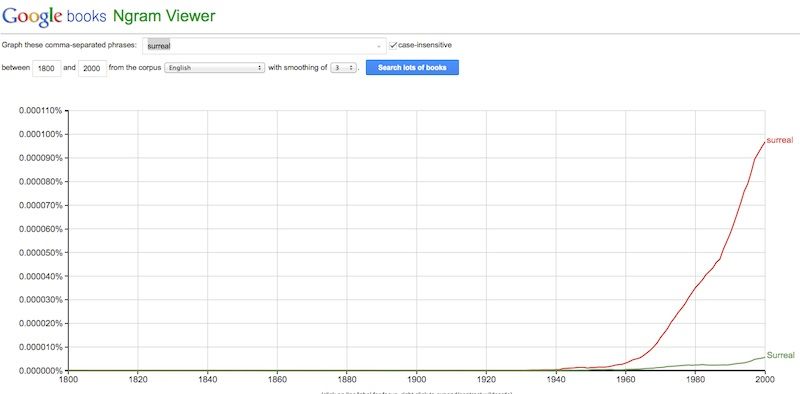
While not entirely relevant, I should perhaps explain that the word “Surrealism” was first coined in the summer of 1917 to describe a Parisian ballet called “Parade.” (This was a month or so after David Taylor-Scott supposedly referred to a “surreal backdrop.”) Regardless, “surreal” and “Surrealism” are two different words with different but related meanings. And the word “surreal” did not come into use until two decades later after the 1917 mention of Surrealism.
Heads Home. The supposed April 16, 1917 journal entry mentioned,
“Mac heads home tomorrow.” I figured a phrase like “heads home” would probably have been around forever. Apparently not.
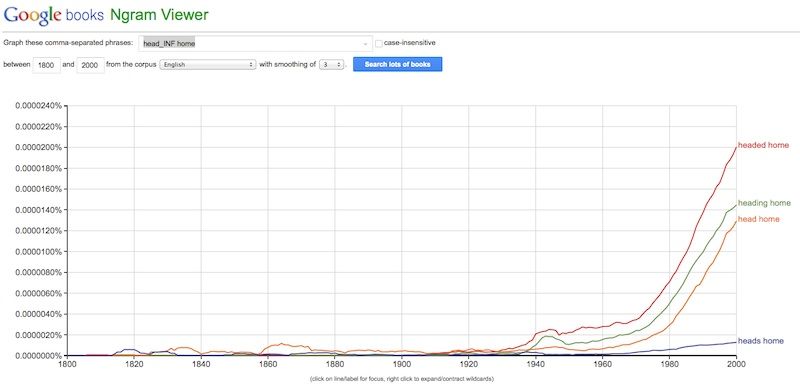
Note that Google Ngram searches cannot filter for meaning, so when a phrase consists of two common words like “head” and “home” they will occasionally up next to each other in texts without connoting this meaning, and so there is bound to be some noise along the bottom of the graph. I’ve looked through a large sample of the search results for the period in question, and found no matches for the usage in the transcriptions.
A Great Read. In the supposed May 28, 1911 journal entry, the author mentioned that he enjoyed reading an article by referring to “a great read.” The author wrote,
“Really looking forward to this article . . . had a great read with a cup of tea and sausage roll.“The phrase, as used, doesn’t seem to have been in existence at the time. (Again there is some noise on the graph because common words sometime show up next to each other in other contexts. After reviewing many of the search results, it looks as if the phrase “great read” (and the related phrase “good read”) were not used in 1901 as they are used in the transcriptions.)
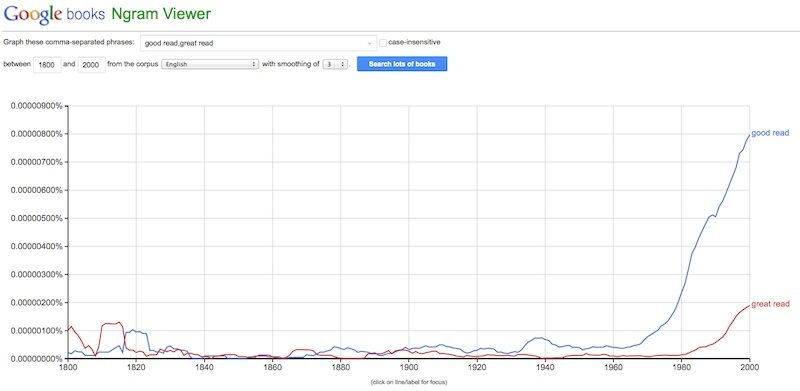 Well There You Go
Well There You Go. The transcription dated July 20, 1901 included the following sentence: “He produced this box thing, a camera he said looked more like a box for holding tea in to me, well there you go.”
The use of “well there you go,” in this fashion seems to be distinctly modern.
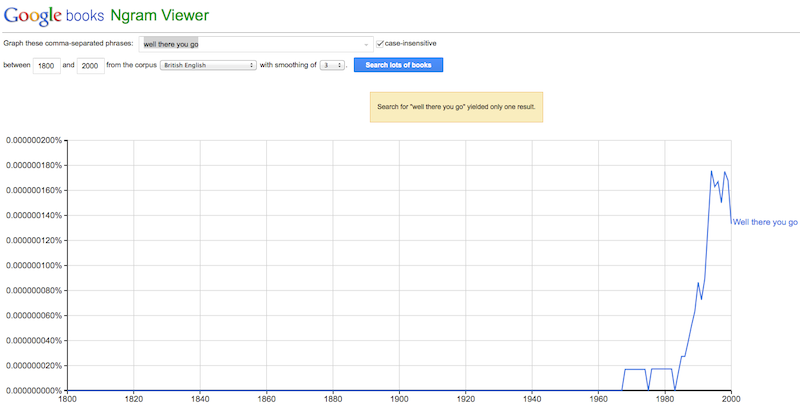 Not My Cup of Tea
Not My Cup of Tea. The supposed May 28, 1901 journal entry contains the idiom “not my cup of tea” to denote something the author did not like: [/i]“I hate interviews, not my cup of tea.”[/i]
It has “tea” in it, so I guess it sounds British enough. Online sources trace its origins to the 1930’s. Also, I searched for the phrase in the British online newspapers archive, and the first related reference I could was from the 1930s. See also
http://www.knowyourphrase.com/phrase-meanings/My-Cup-of-Tea.htmlAdditionally, here is the Google Ngram Viewer image showing the appearance of the phrase in the Google corpora. (Again the small line near 1900 seems to be the result of a single mis-indexed book, as a book published in 2013 is listed as published in 1900.)
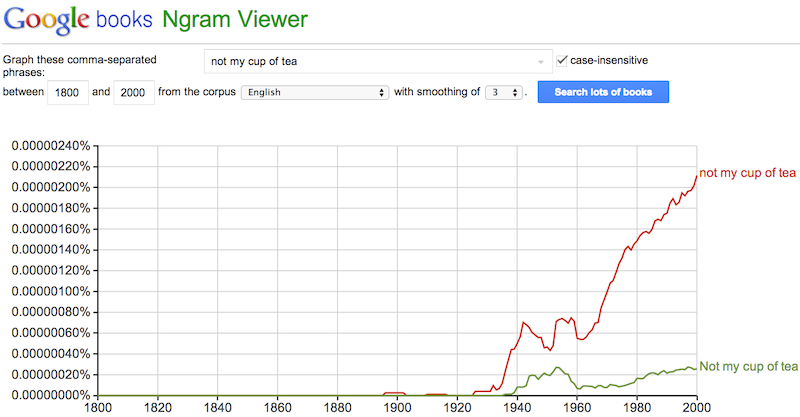 A Bugger of a Trip
A Bugger of a Trip. Supposedly from May 11, 1901. “. . . it was a bugger of a trip.”
The phrase “bugger of a . . .” sounds British to American ears, but was it in use in 1901? Apparently not.
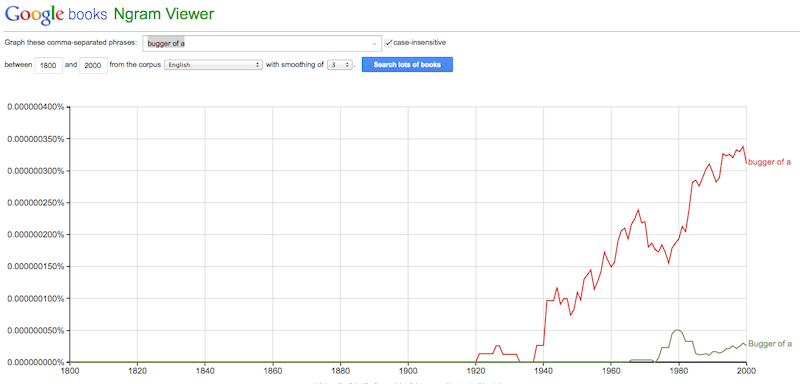 News wise
News wise. Supposedly from May 28, 1901. “Got the late edition newspaper still this mine disaster, not much else news wise.”
Neither “news wise” nor “newswise” was being used in 1901.
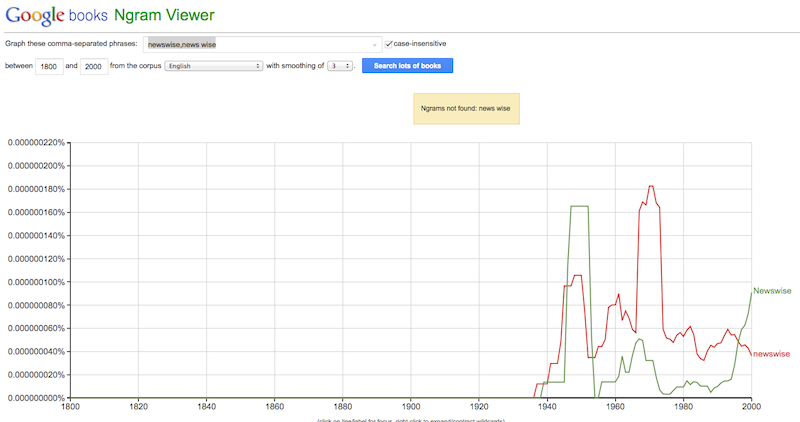
There are more, some of which I will be adding later, but you get the picture. Whoever wrote these journals doesn’t seem to have written them in 1901 or 1917.
The Story of Old Tom’s Mischievous Look, Not Seen “Before or Since.”
One sentence in the supposed journals struck me as so out of place in a journal, that I though it might deserve mention. From the May 11, 1901 transcription: “When I told Old Tom that Alistair MacKenzie would be there, he gleamed with a mischievous look I have not seen before or since.”
Before or since? Isn’t this supposed to be from a journal entry? The “since” in “before or since” only has meaning if the author is looking back at an event after some significant passage of time. “Before or since” sounds as it it came out of a memoir, not a journal The phrase makes no sense in a journal which was supposedly written within hours of the event taking place.
A Belated ‘Thanks’ on Scores Letterhead Sent from Philadelphia, Concerning a Trip Long Passed.
One of the details holding the old story together was the bit about how, the day after the infamous dinner at the Scores Hotel, Tillinghast jotted out a note thanking David Scott-Taylor for his
“hospitality in St. Andrews.” Not only did it confirm Tillinghast’s presence, it also made perfect sense. The timing is right for such a note, and the occasion - the dinner - quite obvious. And the stationary was appropriate because Tillinghast was (supposedly) in St. Andrews. But Tillinghast wasn’t in St. Andrews.
These new supposed journal pages try to address this, just as they conveniently address all of the problems created by Tillinghast having not been there in May 1901. Now the story is that the note must have been sent from Philadelphia, and did not arrive until May 28, 1901.
But why then it is on Scores letterhead? And why would Tillinghast have written out a brief note
on May 12, 1901 thanking David Scott-Taylor for “his hospitality in St. Andrews?” Tillinghast was nowhere near St. Andrews on May 12, 1901.
I guess we are supposed to believe that Tillinghast must have had the stationary from a previous trip, and that he must have been thanking David Scott-Taylor for some past hospitality in St. Andrews during some past golf season. But this makes little sense, especially given that Tillinghast and David Scott-Taylor had supposedly been corresponding regularly, and so there were many opportunities to have thanked him.
[By the way, now that I have pointed this out, I half expect that Ian Scott-Taylor will soon send Phil another journal entry explaining away the strange timing of the note. For good measure, maybe the next round of journal entries will also mention how David TScott-Taylor was close with and poet Guillaume Apollinaire and others who were about to launch the French Surrealism movement, and about how they taught him a neat word that Scott-Taylor decided it might be fun shorten. Surreal.]
And, speaking of Scores Hotel letterhead, how come the image in the story does not show Scores hotel letterhead? And how come the Scott-Taylor family didn’t bother to look at the journals when they photographed this note for Phil’s story?
Affidavits, the British Museum, and Inauthentic Authentication.
I thought I’d briefly address this because Phil, Ran, and others keep suggesting we should accept all this stuff as real because it has all been vetted, verified, and authenticated by about every authority short of the Queen herself. I’ve heard of sworn affidavits, MacKenzie experts, paper dating, the British Museum, handwriting experts, pencil gurus, and I cannot remember what else. Phil went so far as to insist that a solicitor had “personal knowledge” of the exact whereabouts of all the Scott-Taylor material going back for at least 100 years. That must be one old solicitor.
I know this is all supposed to sound very impressive, but I have my doubts. Claims about affidavits and expert opinions aren’t something that one should blindly accept. For one reason, it is easy to overstate the significance of affidavits and expert opinions. For example, we have heard about how the sketches must be real because an expert said at least some of them are on old paper. Sounds impressive, but it is hardly dispositive. If accurate, all this tells us is that the paper was old, but one can find or purchase old paper today. (For example I found a
website selling a variety of old paper, as well as blank diary made around 1902.)
Also, it isn’t necessarily difficult find an expert or even a solicitor to say what you want him or her to say. It is much harder to find one that whose opinion and/or affidavit can stand up to critical scrutiny. Do the affidavits, reports, etc. stand up to critical scrutiny? I couldn't say. I haven't seen them or the actual sketches, journals, etc. Even if I had seen them, I'd probably still have some questions about what exactly has been done to ensure that this material is what it purports to be. There is more to the process than just throwing out the word "affidavit" or quoting Ran.
Plus, remember how we were all told that the Road Hole sketch checked out and it was what they claimed it to be? Well, back then they were claiming it to be a sketch created by Tillinghast in May of 1901 while Tillinghast was in St. Andrews, and dated by Tillinghast, “May 1901.” And at least some of this information is inaccurate. So much for the authentication process regarding these details.
I’d be very interested in seeing the affidavits specifically indicating that these four new journal pages were created in 1901. I am having trouble imagining how one would even word such an affidavit, but i am curious to see it nonetheless.
The End of It? I Wish.
I have many more reservations about the veracity of these stories and the authenticity of the Scott-Taylor Collection, but I’ll stop here for now, because some my other concerns will require me to directly address extended passages from the transcriptions that Phil has not brought public yet. I will hold off on addressing these now so as to avoid confusion, but I did address a few of the questionable words or phrases from these passages here because their usage can easily be understood without getting too deep into the overall context. I don’t want to wait until after Ran and Phil delete the old story and state my concerns because the existence of old story and casts serous doubt on the veracity of the new story, and I am hoping that people will actually consider this before Ran and Phil make the old story disappear.
____________________
ADDENDUM: Corrected formatting, spacing, spelling, grammar, and names.